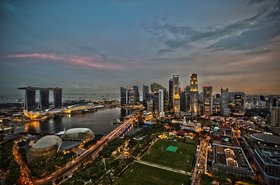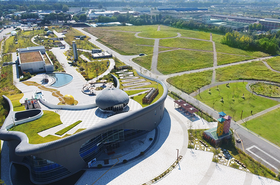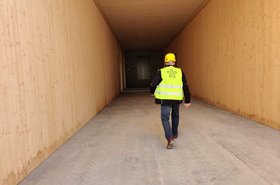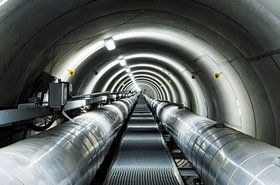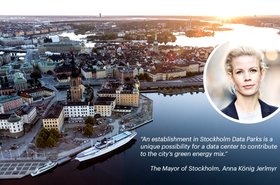Before you build your data center, you need to decide where to build it. Tax breaks are probably one of the most powerful incentives to choose one location over another, along with the availability of fiber and electricity - preferably cheap, green electricity.
But there’s another factor to consider. Data centers don’t exist in isolation. They have needs for services like water and cooling, and there are other industrial sites that actually have complementary needs.
Place your facility near certain kinds of infrastructure and there’s a win-win situation. Some of these friendly sites are exotic, some are simply practical. Here are some ideas:
This feature appeared in the 2021 Building at Scale Supplement. Read for free today.
Natural gas plants
Data centers need cooling, and one place where a huge source of cooling currently goes to waste is at liquified natural gas (LNG) plants.
Natural gas is shipped in tankers, compressed, and cooled into liquid form. When the gas is landed, it has to be vaporized and fed into pipelines. That re-gasification process requires heat energy, so LNG plants could be good partners: a data center’s waste heat energy could pass to the plant and both would benefit.
The idea was proposed by TeraCool some years back. In 2014, Bob Shatten, president of TeraCool, told me: “We think there is a tremendous opportunity. We have had interest from some LNG terminals – now we need to get the data center world to step outside of the box and align their interests at one of these locations.”
As well as cooling, the expansion process creates mechanical energy, which can drive turbines and generate electricity - so the process could also power the data center with renewable energy.
In 2014, Shatten predicted that an LNG terminal in Seoul could provide 350MW of cooling and 87MW of electricity.
After seven years in the wilderness, the idea has re-emerged. The National University of Singapore (NUS) and Keppel Data Centres are developing a prototype at the Singapore LNG Corporation (SLNG)’s terminal on Jurong Island.
Singapore is an especially good location for this: cooling is an issue in its tropical climate, and renewable energy is in short supply.
The drawback is that LNG plants are generally placed far from inhabited areas because of the danger of fire. After this year’s blaze at OVHcloud’s Strasbourg campus, the terminals might hesitate to allow a data center onsite.
So on balance, data centers might not actually move alongside the LNG plants. The Keppel/NUS team is working on ways to transport the cold energy away from the SLNG plant to data centers elsewhere in Singapore.
Sewage plants
Not everyone would want to live and work in a sewage plant, but California-based Tomorrow Water reckons data centers would fit in perfectly there.
“Data centers need space and they also need to cool - and they need water,” says Jon Liberzon, vice president at Tomorrow Water. “At a waste water treatment plant, there are tons of water available for free. There’s no question of the security of supply.”
The synergy is actually a lot better than that, Liberzon explained to DCD. Sewage plants, or waste water recovery facilities (WWRFs) as they prefer to be known, have free space available, and also use processes that could help cool data centers.
Most WWRFs are long-established sites in densely populated areas. You might think such sites would have no physical space for a data center, but new water treatment are creating space there.
Much of the land area in traditional WWRFs is given to sedimentation tanks. Tomorrow wants to replace these with biofiltration systems that take up 80 percent less space. In 2017, the company’s Korean parent rolled out the technology in a flagship project in Jungnang, Seoul, using the reclaimed space for a new park and a Sewage Museum.
Now, Tomorrow is seeking partners for the Tomorrow Water Project, which would partly fund WWRF upgrades with data center partners, who get land, water and cooling - along with green energy from methane produced on-site.
Data center waste heat can speed up biological treatment processes at WWRFs, drying sludge, and improving reaction rates in digesters producing methane from organic matter. The data center would also run AI services to increase the efficiency of the overall project.
The idea is most attractive where space and water are at a premium, so Singapore might be a suitable site, or California, where Tomorrow is based.
"Finding the space for data centers presents a challenge since they are most needed in major metropolitan areas where land is limited or in areas where necessary infrastructure is lacking. For instance, land prices in Loudoun County near Washington DC where data centers for Google, Microsoft, and Amazon are concentrated have more than doubled in recent years," says the Tomorrow Water announcement.
"The concept of building a WRRF alongside a data center is expected to be a particularly attractive alternative for large cities in the United States that are experiencing budget reductions due to the Covid-19 pandemic," said Kim Dong-woo, CEO and founder of BKT and Tomorrow Water.
While Tomorrow Water is working on ambitious prototypes, the idea of data centers at sewage plants was actually proposed nearly ten years ago by Microsoft, and then put into practice with a prototype data plant at the Dry Creek water treatment center in Cheyenne Wyoming which opened in 2015. The plant used fuel cells to produce energy from the site’s methane.
Biofuel
Several projects have attempted to marry data centers to biofuels outside the walls of sewage plants.
Biofuels are renewable, but they have some advantage over wind and solar because they are available continuously. However, the track record for such projects is not good.
In 2012, Infinity SDC placed a 500kW data center on a business park at Rendlesham in rural Suffolk, with plans to expand to 4.5MW, all of which could be provided from a bio-digester fed by agriculture waste from nearby vegetable farms.
The site had access to 25 tonnes a day of agricultural waste and alongside methane it produced fertilizer as a by-product, “What comes out is basically 22 tons of water plus all the nitrogen phosphate, potash and magnesium, as well as non-degradable carbon, which is excellent for the soil. All we strip out is CH4 and CO2, the rest can be used to grow the next crops,” said Graham Thorne of AgriGen, who provided the biodigester.
“We certainly have some prospects,” Infinity’s Nigel Stevens told me in 2012. “We have an incredible diversity of power and resilience.” As well as the biodigester, the site had two 33kV feeds from the local grid, and fiber which had been laid for the nearby BT research site at Martlesham.
Sadly, the site was 100 miles from London, and Infinity found that businesses at that time preferred to keep their servers in easy reach, so the experiment lapsed.
Another plan proposed a data center in an old paper mill in Glenrothes, Scotland, close to a biomass generation plant fueled by woodchips. Queensway Park won approval, and was to be built by partner Etix Everywhere of Luxembourg.
However, Etix was bought by Vantage, and the product seems to be in limbo. Queensway recently featured on a list of ten potential data center sites published by the Scottish government.
But one site which has made it work is EcoDataCenter in Falun, Sweden. The facility is close to a combined heat and power (CHP) plant which burns waste wood and makes wood pellets for heating across Sweden.
As well as using the renewable power from the CHP plant, EcoDataCenter sends up to 10MW of waste heat back there, where it is used to dry pellets for burning and export.
This helps the plant produce pellets all year round without needing more energy to dry them: “with a data center nearby, we can prolong the season,” Falu Energi’s sustainable development engineer Lars Runevad told DCD in 2019. “We can produce more wood pellets than otherwise. We may also be able to [stop] the propane excess needed to top it up.”
EcoDataCenter also used wood in its construction, reducing its embodied carbon footprint. “We use cross-laminated glulam wood,” development manager Jan Fahlén told DCD, explaining it is much more sustainable as it creates much less carbon dioxide than concrete.
Housing
We’ve suggested some quite exotic sites to put data centers, but there’s also a major opportunity in developing alongside the most basic type of buildings: housing.
Here is the idea: data centers in cities can give (or sell) their waste heat to warm up surrounding homes and office buildings. The energy used in the data center gets used twice, and the city can turn off some fossil-powered heating, reducing its footprint.
The concept has taken off slowly, but some data centers are putting it into practice in Scandinavian countries like Denmark and Sweden, which have a low enough temperature for heating to be needed for many months of the year, and a lot of government-installed district heating systems to deliver the waste heat to customers.
The European Union approves of the idea. Its environmental rules require large fossil-powered industrial plants to explore connecting to district heating systems. This does not apply to data centers, because they run on electricity - and can theoretically adopt renewable supplies.
However, at the start of 2021 European operators promised, in the Climate Neutral Data Center Pact, that all operators should at least explore the options for heat reuse.
And Norway’s government has proposed that all data centers with a capacity of more than 2MW should offer their heat to district heating.
"The EU first and foremost sets requirements for plants with thermal energy. But we believe it is appropriate to set requirements for data centers as well," said Energy Minister Tina Bru. She points out that if a data center is not near homes, there may be industrial sites, fish farms, or swimming pools that could use the heat.
Right now, however, most data center waste heat is low quality, in the form of warm air at 30C to 40C. This is hard to transport and use. But in future, if liquid cooling comes into play, the thermodynamics changes the economics. Hot water is much more use than warm air, and data centers could provide hot water in more climates.

